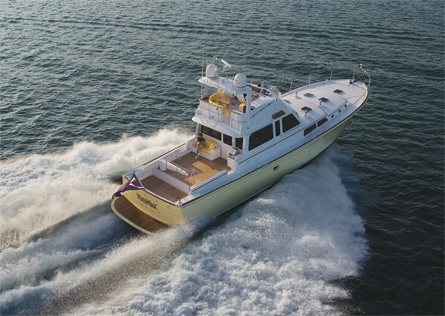
lymanmorse62lrg445.jpg
Sandy and Helen Jones christened their new 62-foot motoryacht MadMax, after their grandson. He must be quite a character, and according to the Joneses, he loves being on the boat. Who wouldn’t? The intelligently designed interior, the exquisitely rendered joinery and soft colors welcome guests with open arms. Although I found nothing “mad” about the boat, everything aboard her seemed to have been taken to the max-maximum quality, maximum comfort, maximum livability.
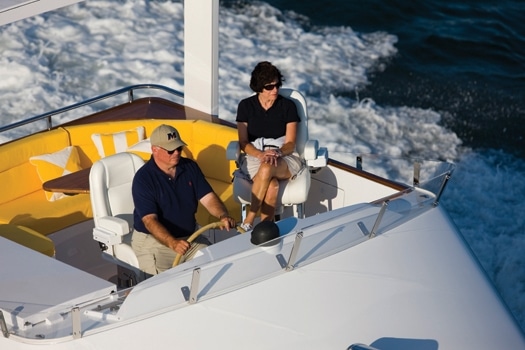
| | |
MadMax came to life from a perfectly executed recipe of highly experienced owners, a fine designer and an accomplished boatbuilder. The makings began to mix when the Joneses dropped by Lyman-Morse in the summer of 2005 to tour the yard, as part of a search for the builder of their ultimate powerboat. After reviewing the couple’s design brief, Lyman-Morse asked designer Doug Zurn to meet with the Joneses at the yard. The ingredients seemed to complement one another very well, so the process moved forward. About thirty months later, MadMax touched water for the first time and officially began her preliminary sea trials. By June of 2008, the Joneses had christened her at the launching party in Thomaston, Maine, and this past August, she made her public debut at the Maine Boats, Harbors and Home Show in Rockland. That’s where I joined the Joneses, Doug Zurn and Lyman-Morse’s J.B. Turner for my sea trial.
Painted Fighting Lady Yellow, MadMax stood out from the rest of the boats in the show-sort of like an S-Class Mercedes in a showroom full of Smart Fortwos. Sandy, a fireplug of a man with a gentle nature to complement his aura of authority, greeted me in the lower cockpit, where the tender will live when the boat’s underway. He spent 20 years at sea aboard container ships, seven of those as master. Helen, slim and charmingly forthright, grew up in a boating family. She bustled about the interior, removing the clutter that goes with exhibiting at a boat show. Both of them hail from Long Island, New York, and had sailed their 35-foot sloop along the East Coast, from Long Island Sound to the chilly waters of Maine, before they settled in San Francisco. In spite of the long absence from their hometown, neither one has lost the distinctive New York accent, nor are they timid about expressing their opinions. That’s how MadMax got to be the way she is.
Although this yacht is relatively small for her length-narrower than is customary for a motoryacht of this type and as light in weight as prudent scantlings permit-her sweeping sheerline and upright superstructure demand one’s attention. Her styling is conservative, the sort that never really loses favor among yachting’s cognoscenti, and it reflects some of the requirements created by the spaces inside the boat. Foremost among those: She had to be a comfortable home, aboard which they could enjoy all that the sea has to offer. The yacht had to be fast, seakindly, easy for the two of them to handle, and roomy enough to house family and friends who wish to stay overnight or a few days.
Zurn’s design for this hull resembles that of the MJM 34z and her siblings-the fine entry warps into a straight run of moderate deadrise. The chines fall just short of joining at the stem, and they rise from the static waterline at about station 3. They angle downward and aren’t especially wide. Inboard of each chine, strakes, one on each side, add lift and help direct the water outward. The forward sections, inches abaft the bow thruster cavity, have a short strake on each side fairly near the keel. These resemble the dive planes at the outside edges on the nose of the Rolex Daytona Prototype race cars. On the cars, they provide aerodynamic downforce. On MadMax, they are the first line of defense against spray, and they prevent the bow from digging into waves.
Narrow hulls generally require less power to reach plane and less power to maintain their cruising speed. Equally important to speed and economy, the designer and builder have to monitor the weight of each component. Lyman-Morse molded the hull, deck and superstructure of MadMax via the SCRIMP method of resin infusion. In addition to eliminating the evaporation of the resin’s harmful fumes, this system prevents voids in the laminate and insures the proper resin- to-glass ratio, helping to keep the boat from gaining weight. Inside, lightweight core materials in the furniture further reduce weight. Putting the structure on a strict diet allows the team to install all the comforts and conveniences of a shoreside dwelling without increasing the weight beyond the target.
The initial sea trials for MadMax proved that Zurn’s approach works. On a cold day this past December, Zurn reported, the boat running in lightship condition planed quickly, exceeded his projection of 32 knots top speed, and felt as agile as a boat half her size. By the time I got to the boat, she had gained weight, as you’d expect of a boat that was ready to set off on a long cruise Down East. When the show dispersed at Rockland Harbor, we headed for open water. The yacht’s 36-inch five-blade props turn in beautifully formed pockets, reducing the draft to 4 feet, 3 inches. The leading edge of each pocket blends almost imperceptibly with the run, and the pocket grows in volume as it approaches the transom. The shape reduces turbulence, allowing the props to chew on all the solid water they need.
To this day, I don’t know exactly how Zurn gets a boat of this size and relatively heavy displacement to behave like a large runabout. She turns quickly and accurately, shoulders her way into a sharp turn without heeling very much, and maintains a level ride from displacement speed to maximum. And quiet-the lack of noise we experienced in the pilothouse at all speeds was eerie. Although relatively calm seas prevented us from testing the yacht’s motion in rougher going, my experience aboard other examples of Zurn’s designs leads me to believe that her seakeeping and ride comfort will be excellent. Also, please note that top speed on the day fell short by 200 rpm, due to the propellers not being optimum for the load. New props were on the way.
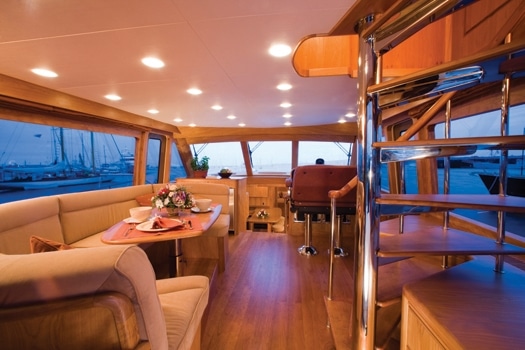
| | |
After a day at sea, Sandy and Helen get to relax in one of the most welcoming interiors I’ve seen. The common area on the bridge deck glows in abundant natural light from the large windows. Even when I sat on the settee, I could easily see our surroundings outside the boat. If you ever get a chance to go aboard MadMax, you’re likely to fall in love with the spiral stairway to the flying bridge. Treads of a light-colored hardwood seem to hang suspended from the stainless stanchions and coil of wooden banister. The staircase enticed me to ascend and descend just for the pleasure of it. The helm is a masterpiece of ergonomic design-placing the navigation screens within one’s line of sight, and all of the controls within easy reach. Once you get your hands on the lovely wood-rim steering wheel, you won’t want to let go, it feels that good.
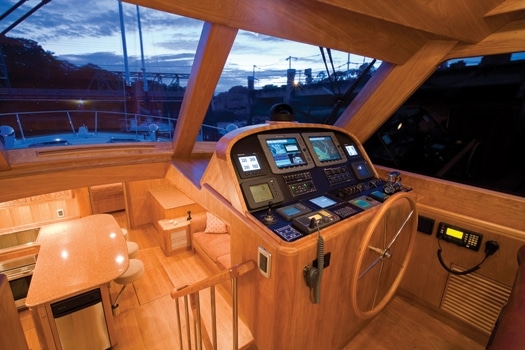
| | |
The wonderful bright glow we enjoyed on the bridge deck carries into the common area belowdecks. Natural light from the windshield at the helm, from the large side windows in the trunk cabin, and from two hatches in the overhead ignite the birch and cherry joinery in the galley and dinette. Helen Jones calls this area the great room, and I can’t think of a more fitting moniker. Whether you’re eating breakfast at the counter-the stools swing out and don’t interfere with one’s passage to the accommodations in the bow-or lounging on the settee watching the flip-down television, this space asks everyone aboard to kick off their shoes and unwind. The settee converts to a berth, primarily for the Jones’ grandchildren. Immediately forward of the settee, MadMax’s utility area has a washer and dryer, a workbench and a fold-down ironing board.
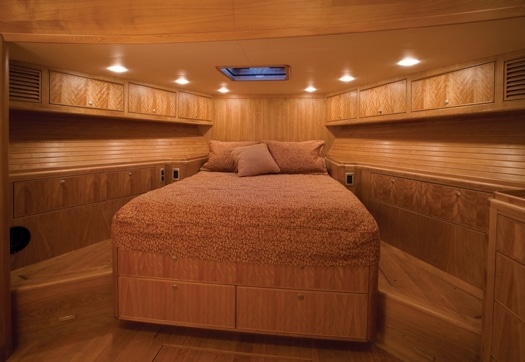
| | |
Sandy and Helen wisely chose to have the master stateroom amidships. This is the area of least motion, and it’s wide enough to permit a full king-size berth, more stowage than most folks will ever need-a huge hanging locker among those spaces-and a humansize head. The exquisite grain of the birch panels and natural light from the portlights make this a most inviting area-never mind that occupants will spend most of their time asleep.
Although MadMax is only 62 feet long on deck, her careful design, construction and thoughtful outfitting bring the world of superyachting to a boat of manageable size and economy of operation. We, of course, have barely uncovered the surface in these few pages, but we have clearly established that great things come in packages of reasonable size. I predict that the Joneses will have the best of times wandering the planet’s waters aboard MadMax.
Lyman-Morse Boatbuilding, (207) 354-6904; www.lymanmorse.com









